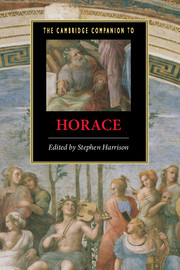11 - Carmina: Odes and Carmen Saeculare
from Part 2: - Poetic Genres
Published online by Cambridge University Press: 28 May 2007
Summary
(Oliver Lyne, in memoriam) Modernity hit downtown Berlin on 3 October 1760, driven and unstoppable like a cannonball. Actually, it was a cannonball. The Russian gun established a very provisional record for long-distance bombing of a city, just at the end of the Seven Years War. The Prussian Horace, Karl Wilhelm Ramler, rose to the occasion. He was ready for it. Thanks to his favourite poet, he knew how to sing about private and public destinies, and the unforeseen dangers of life; he knew that the best poetic strategy for a successful lyric was none other than apostrophe:
Ode Auf ein Geschütz
(Lyrische Gedichte, Reuttlingen 1782, 69)Ode to a Cannon
O du, dem glüuhend Eisen, donnernd Feuer
Aus offnem Aetnaschlunde stammt,
Die frommen Dichter zu zerschmettern, Ungeheuer,
Das aus der Hölle stammt!
O thou, whose glowing iron and thundering fire
Come from Etna’s open jaws,
To shatter virtuous poets - monster,
That comes from Hell itself!
War technology made progress over the next 150 years, and at the end of this cycle another poet steeped in Horace realised that gas attacks were making traditional lyric not only impossible but poisonous: however, he still needed Horace to make this contradiction felt:
My friend, you would not tell with such high zest
To children ardent for some desperate glory,
The old Lie: Dulce et decorum est
Pro patria mori.
(Wilfred Owen, Dulce et decorum est, 1917)- Type
- Chapter
- Information
- The Cambridge Companion to Horace , pp. 144 - 162Publisher: Cambridge University PressPrint publication year: 2007
- 7
- Cited by

